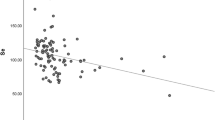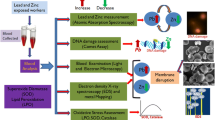Abstract
Workers involved in battery manufacturing or recycling factories are occupationally exposed to high concentrations of lead. In humans, lead can cause a wide range of biological effects depending upon the level and duration of exposure. The purpose of this study was to find out the blood lead levels (BLL) in occupationally exposed workers involved in battery industry in Delhi NCR region and to study whether lead affected the vitamin D (vit D) and calcium metabolism. For this study 100 occupationally lead-exposed battery workers (LEBW) and 100 non-lead exposed controls (NLEC) were recruited. BLL were measured using inductively coupled plasma optical emission spectrometer (ICP-OES) technique while ELISA was performed to quantify the serum vit D levels in the study subjects. Routine biochemical parameters were measured by chemistry autoanalyzers. Statistical analysis was done using appropriate statistical tools. Results showed that BLL were significantly higher in LEBW as compared to NLEC (p < 0.0001). Serum vitamin D, calcium and phosphorus levels were significantly decreased in battery workers as compared to controls (p < 0.005). Spearman’s rank correlation analysis showed significant negative correlation of BLL with serum Vitamin D and calcium levels. Significant positive correlation was observed between BLL and duration of lead exposure. Weak negative correlation was also observed between BLL and vit D even after adjusting for smoking status. In conclusion, this study demonstrated that higher BLL significantly alters the vit D and calcium metabolism.



Similar content being viewed by others
References
Agency for Toxic Substances and Disease Registry (ATSDR). Toxicology profilr for lead,USDepartment of health and human servies. Atlanta, Georgia, USA:US Government Printing,2005; pp 102–225.
International Programme on Chemical Safety (IPCS). Inorganic lead. Environmental health criteria 165. Geneva: WHO; 1995
Ooi PL, Goh KT, Heng BH, Sam CT, Kong KH, Rajan U. Biological monitoring of human exposure to environmental lead in Singapore. Rev Environ Health. 1991;9(4):207–13.
Wu S, Peng S, Zhang X, Wu D, Luo W, Zhang T, Zhou S, Yang G, Wan H, Wu L. Levels and health risk assessments of heavy metals in urban soils in Dongguan. China J Geochem Explor. 2015;148:71–8.
Centers for Disease Control and Prevention (CDC). Adult blood lead epidemiology and surveilance. MMWR Morb Mortal Wkly Rep. 2011;60:841.
International Agency for Research on Cancer (IARC). Inorganic and organic lead compounds. IARC Monogr Eval Carcinog Riska Hum. 2006;87:1.
Luo W, Ruan D, Yin C, Chen J. Effects of chronic lead exposure on functions of nervous system in Chinese children and developmental rats. Neurotoxicolocy. 2012;33:862–71.
Braun JM, Hoffman E, Schwartz J, Sanchez B, Schnaas L, Mercado-Garcia A, et al. Assessing windows of susceptibility to lead-induced cognitive deficits in Mexican children. NeuroToxicology. 2012;33(5):1040–7.
Arbuckle TE, Davis K, Boylan K, Fisher M, Fu J, Bisphenol A. Phthalates and lead and learning and behavioral problems in Canadian children 6–11 years of age: CHMS 2007–2009. NeuroToxicology. 2016;54:89–98.
Roy A, Queirolo E, Peregalli F, Mañay N, Martínez G, Kordas K. Association of blood lead levels with urinary F2-8α isoprostane and 8-hydroxy-2-deoxy-guanosine concentrations in first-grade Uruguayan children. Environ Res. 2015;140:127–35.
Dallaire R, Dewailly É, Ayotte P, Forget-Dubois N, Jacobson SW, Jacobson JL, et al. Growth in Inuit children exposed to polychlorinated biphenyls and lead during fetal development and childhood. Environ Res. 2014;134:17–23.
Skröder H, Hawkesworth S, Moore SE, Wagatsuma Y, Kippler M, Vahter M. Prenatal lead exposure and childhood blood pressure and kidney function. Environ Res. 2016;151:628–34.
De Silva PE. Determination of lead in plasma and studies on its relationship to lead in erythrocytes. Occup Environ Med. 1981;38(3):209–17.
Mudipalli A. Lead hepatotoxicity & potential effects. Indian J Med Res. 2007;126:518–27.
Janin Y, Couinaud C, Stone A, Wise L. The, “lead-induced colic” syndrome in lead intoxication. Surg Annu. 1985;17:287–307.
Gidlow DA. Lead toxicity. Occup Med. 2004;54(2):76–81.
Dongre NN, Suryakar AN, Patil AJ, Hundekari IA, Devarnavadagi BB. Biochemical effects of lead exposure on battery manufacture workers with reference to blood pressure, calcium metabolism and bone mineral density. Indian J Clin Biochem. 2013;28(1):65–70.
Hass GM, Brown DV, Eisenstein R, Hemmens A. Relations between lead poisoning in rabbit and man. Am J Pathol. 1964;45:691–727.
Mazumdar I, Goswami K, Ali MS. Status of serum calcium, vitamin D and parathyearoid hormone and hematological indices among lead exposed jewelry workers in Dhaka, Bangladesh. Indian J Clin Biochem. 2017;32(1):110–6.
Kemp FW, Neti PVSV, Howell RW, Wenger P, Louria DB, Bogden JD. Elevated blood lead concentrations and vitamin D deficiency in winter and summer in young urban children. Environ Health Perspect. 2006;115(4):630–5.
Ahmad I, Khan B, Khan S, Khan MT, Schwab AP. Assessment of lead exposure among automobile technicians in Khyber Pakhtunkhwa, Pakistan. Sci Total Environ. 2018;633:293–9.
Basit S, Karim N, Ali SS, Solangi SUH, Khan FA, Munshi AB. Occupational lead toxicity in battery workers of Karachi. Pak J Med Sci. 2015;31(4):775.
Ahmad SA, Khan MH, Khandker S, Sarwar AFM, Yasmin N, Faruquee MH, et al. Blood lead levels and health problems of lead acid battery workers in Bangladesh. Sci World J. 2014;2014:1–7.
Juberg DR, Kleiman CF, Kwon SC. Position paper of the American council on science and health: lead and human health. Ecotoxicol Environ Saf. 1997;38(3):162–80.
Smith CM, DeLuca HF, Tanaka Y, Mahaffey KR. Effect of lead ingestion on functions of vitamin D and its metabolites. J Nutr. 1981;111(8):1321–9.
Schwalfenberg GK, Genuis SJ. Vitamin D, essential minerals, and toxic elements: exploring interactions between nutrients and toxicants in clinical medicine. Sci World J. 2015;2015:1–8.
Anticona C, San Sebastian M. Anemia and malnutrition in indigenous children and adolescents of the Peruvian Amazon in a context of lead exposure: a cross-sectional study. Glob Health Action. 2014;7(1):22888.
Ren W, Gu Y, Zhu L, Wang L, Chang Y, Yan M, et al. The effect of cigarette smoking on vitamin D level and depression in male patients with acute ischemic stroke. Compr Psychiatry. 2016;65:9–14.
Author information
Authors and Affiliations
Corresponding author
Ethics declarations
Conflict of interest
The authors declare that they have no conflict of interest.
Research Involving Human Participants and/or Animals
This article involves participations of human subjects with the approval from Ethical Committee, SGT University, Gurgaon, Haryana, India (No. SGTU/FMHS/D/2015/Dated 17.09.2015)
Informed Consent
Prior written informed consent was obtained from all subjects recruited in this study.
Rights and permissions
About this article
Cite this article
Himani, Kumar, R., Ansari, J.A. et al. Blood Lead Levels in Occupationally Exposed Workers Involved in Battery Factories of Delhi-NCR Region: Effect on Vitamin D and Calcium Metabolism. Ind J Clin Biochem 35, 80–87 (2020). https://doi.org/10.1007/s12291-018-0797-z
Received:
Accepted:
Published:
Issue Date:
DOI: https://doi.org/10.1007/s12291-018-0797-z




